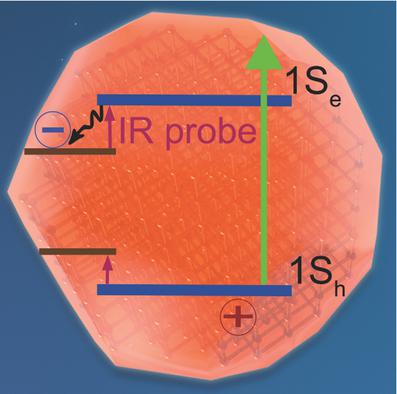当前位置:
X-MOL 学术
›
Adv. Electron. Mater.
›
论文详情
Our official English website, www.x-mol.net, welcomes your
feedback! (Note: you will need to create a separate account there.)
Revealing Trap States in Lead Sulphide Colloidal Quantum Dots by Photoinduced Absorption Spectroscopy
Advanced Electronic Materials ( IF 5.3 ) Pub Date : 2017-12-05 , DOI: 10.1002/aelm.201700348 Simon Kahmann 1, 2 , Mykhailo Sytnyk 3 , Nadine Schrenker 4 , Gebhard J. Matt 2 , Erdmann Spiecker 4 , Wolfgang Heiss 3 , Christoph J. Brabec 2, 5 , Maria A. Loi 1
Advanced Electronic Materials ( IF 5.3 ) Pub Date : 2017-12-05 , DOI: 10.1002/aelm.201700348 Simon Kahmann 1, 2 , Mykhailo Sytnyk 3 , Nadine Schrenker 4 , Gebhard J. Matt 2 , Erdmann Spiecker 4 , Wolfgang Heiss 3 , Christoph J. Brabec 2, 5 , Maria A. Loi 1
Affiliation

|
Due to their large surface to volume ratio, colloidal quantum dots (CQDs) are often considered to exhibit a significant amount of surface defects. Such defects are one possible source for the formation of in‐gap states (IGS), which can enhance the recombination of excited carriers, i.e., work as electrical traps. These traps are investigated for lead sulphide CQDs of different size, covered with different ligands using a mid‐infrared photoinduced absorption (PIA) technique. The obtained PIA spectra reveal two distinct absorption bands, whose position depends on the particle size, i.e., the electronic confinement in the CQDs. Smaller particles exhibit deeper traps. The chemical nature of the capping ligand does not affect the resulting position other than due to its change in confinement, but better passivating species lead to smaller signals. Furthermore, ligand specific narrow lines observed are superimposed on the broad electronic background of the PIA spectra, which is attributed to Fano resonances caused by the interplay of the narrow molecular vibrations and the continuum of trap states. Mid‐infrared photoinduced absorption represents a valuable tool to unravel distributions of IGS in CQDs and allows for an assessment of the quality of ligand exchanged films. These findings have implications for understanding the performances of CQD‐based (opto‐) electronic devices, such as solar cells, transistors, or quantum dot light emitting diodes, which are limited by frequent carrier trapping events.
中文翻译:

通过光致吸收光谱揭示硫化铅胶体量子点中的陷阱态
由于其大的表面体积比,胶体量子点(CQD)通常被认为表现出大量的表面缺陷。此类缺陷是形成间隙状态(IGS)的一种可能来源,它可以增强受激载流子的重组,即起电子陷阱的作用。使用中红外光诱导吸收(PIA)技术对这些阱进行了大小不同,覆盖有不同配体的硫化铅CQD的研究。所获得的PIA光谱揭示了两个不同的吸收带,其位置取决于颗粒大小,即CQD中的电子限制。较小的颗粒显示出更深的陷阱。封端配体的化学性质除了由于其限制变化外,不影响最终位置,但是更好的钝化物种导致较小的信号。此外,观察到的配体特异性窄线叠加在PIA光谱的宽电子背景上,这归因于由窄分子振动的相互作用和陷阱态的连续性引起的Fano共振。中红外光诱导吸收是揭示CQD中IGS分布的有价值的工具,并可以评估配体交换膜的质量。这些发现对于理解基于CQD的(光电)电子设备(例如太阳能电池,晶体管或量子点发光二极管)的性能具有重要意义,这些设备受频繁的载流子捕获事件限制。这归因于由窄分子振动的相互作用和陷阱态的连续性引起的法诺共振。中红外光诱导吸收是揭示CQD中IGS分布的有价值的工具,并可以评估配体交换膜的质量。这些发现对于理解基于CQD的(光电)电子设备(例如太阳能电池,晶体管或量子点发光二极管)的性能具有重要意义,这些设备受频繁的载流子捕获事件限制。这归因于由窄分子振动的相互作用和陷阱态的连续性引起的法诺共振。中红外光诱导吸收是揭示CQD中IGS分布的有价值的工具,并可以评估配体交换膜的质量。这些发现对于理解基于CQD的(光电)电子设备(例如太阳能电池,晶体管或量子点发光二极管)的性能具有重要意义,这些设备受频繁的载流子捕获事件限制。
更新日期:2017-12-05
中文翻译:

通过光致吸收光谱揭示硫化铅胶体量子点中的陷阱态
由于其大的表面体积比,胶体量子点(CQD)通常被认为表现出大量的表面缺陷。此类缺陷是形成间隙状态(IGS)的一种可能来源,它可以增强受激载流子的重组,即起电子陷阱的作用。使用中红外光诱导吸收(PIA)技术对这些阱进行了大小不同,覆盖有不同配体的硫化铅CQD的研究。所获得的PIA光谱揭示了两个不同的吸收带,其位置取决于颗粒大小,即CQD中的电子限制。较小的颗粒显示出更深的陷阱。封端配体的化学性质除了由于其限制变化外,不影响最终位置,但是更好的钝化物种导致较小的信号。此外,观察到的配体特异性窄线叠加在PIA光谱的宽电子背景上,这归因于由窄分子振动的相互作用和陷阱态的连续性引起的Fano共振。中红外光诱导吸收是揭示CQD中IGS分布的有价值的工具,并可以评估配体交换膜的质量。这些发现对于理解基于CQD的(光电)电子设备(例如太阳能电池,晶体管或量子点发光二极管)的性能具有重要意义,这些设备受频繁的载流子捕获事件限制。这归因于由窄分子振动的相互作用和陷阱态的连续性引起的法诺共振。中红外光诱导吸收是揭示CQD中IGS分布的有价值的工具,并可以评估配体交换膜的质量。这些发现对于理解基于CQD的(光电)电子设备(例如太阳能电池,晶体管或量子点发光二极管)的性能具有重要意义,这些设备受频繁的载流子捕获事件限制。这归因于由窄分子振动的相互作用和陷阱态的连续性引起的法诺共振。中红外光诱导吸收是揭示CQD中IGS分布的有价值的工具,并可以评估配体交换膜的质量。这些发现对于理解基于CQD的(光电)电子设备(例如太阳能电池,晶体管或量子点发光二极管)的性能具有重要意义,这些设备受频繁的载流子捕获事件限制。











































 京公网安备 11010802027423号
京公网安备 11010802027423号